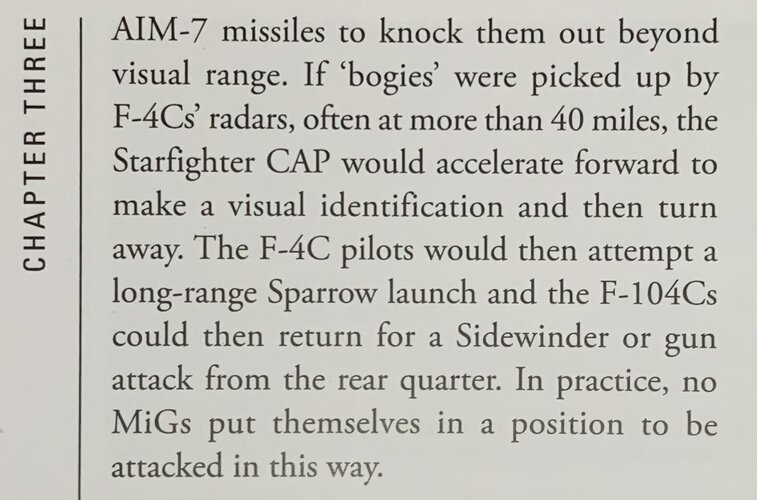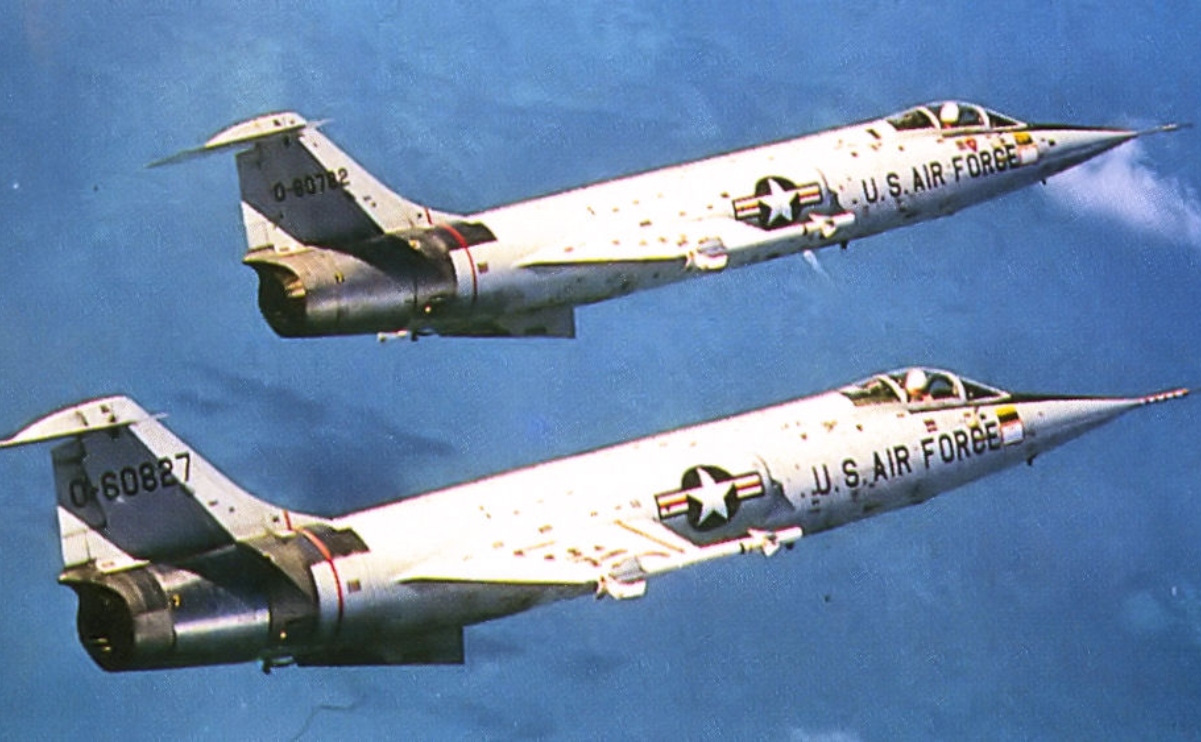- Joined
- 15 July 2007
- Messages
- 4,889
- Reaction score
- 4,554
And just to confuse but perhaps add a influence on more F104s.....
This is the alternate history section, dude. Either read the above posts or don't post if you don't like the idea.
There is interesting stuff in that discussion.
For example: the Air Force had that peculiar idea of using CL-901s as backups to Phantom's Sparrows. In case the AIM-7s failed at medium range (as they often did) a pack of CL-901s flying ahead of the F-4s would step in to kills the MiGs with either Sidewinders or gun fire.
I started the thread with the idea of Sparrow-armed Starfighters fighting in Vietnam. I learned that Starfighters were considered as AIM-7 backups.


How many 104S have been modified with a similar probe ?Here it is:Do you have pictures of an Italian 104S with a refueling probe ?Of course the F-104C got a fixed refuelling probe and the F-104S ASA got it also at the end of the 80's when, finally, Italian goverment decided to by 4 Boeing KC-707 for the Italian air force.
View attachment 691106
A fictive Zipper with R-550, S-530 & a F1 type probe.Ok, I can see why that thing was draggy. And it is very similar indeed to the F-104C 's own probe (how surprising - why reinvent the wheel three decades after ?)
Something I never quite understood (also applies to the upgraded Mirage Vs that got similar ugly & draggy probes) is - why not copy the Mirage F1 setup ? As far as the pointy nose, windshield and air intakes are concerned, the 104, Mirage V and F1 are very similar.
I have this suspicion the 1950's aircraft fuel tanks or fuel lines were in the wrong place to get a F1 boom.
Why did upgraded Mirage V and F-104S got a boom on the air intake shoulder ? when F1 had it planted near the windshield ?
Because the U-2 flights over the Soviet Union proved the nonexistence of a Russian intercontinental bomber force that was previously assumed to exist. The emphasis changed to defense against an ICBM attack. Of course, the technology to do that wasn't up to snuff at the time, so all the USAF and Army could do was propose future systems for the most part while putting some stopgap ones in place to at least show they were doing something.Didn't we already cover this in a previous thread? The f-104 is worse in all the ways that gave the f-4 trouble in vetnam, not that it particularly matters sense the f-4 was fine it was how the usaf fought in vetnam that was pants on head stupid. But if your not going to change how the usaf fought then the f-104 is going to do way worse then the f-4 did, if your going to fight the same war the cursader 3 or f11f-1 would be far better, and if you do change how the war is fought then the f-4 is fine.
What are you talking about? If the interceptor mission was what got congress excited then why were only 350 f-106 biult instead of the 1000 planed? Or why was the f-108 canceled.You have to remember in all of this the politics and missions the USAF saw as important. For the USAF, Vietnam was something of a sideshow. Sure, they put a lot of planes and effort in, but the money and mission that was at the top of the list insofar as fighter / interceptor aircraft went was air defense of the continental US. That was where the money from Congress was going.
For that mission, the USAF wanted the F-106. The F-104 was considered nothing but a stopgap that ADC really never wanted. The 104 couldn't use SAGE and that made it marginal as an interceptor in ADC's eyes. The F-102 was accepted as the interim all-weather interceptor until Convair could get the 106 into production. Ground attack and TAC were way down the USAF's priority list for funding. After all, that mission tied them to their rival, the US Army and that didn't go down well.
The 104 was pretty much a day air superiority fighter and that mission wasn't selling to the money people in the Capitol building or at the top of the USAF's food chain. So, regardless of how good or whatever the 104 might be at something, it was going to be a 'no sale' to the people that made funding decisions. They wanted all-weather interceptors working with SAGE, and the stuff going to Vietnam were really the leftovers.
It's a bit off topicIf the F-104S had been used successfully against MiGs in Vietnam, it could have cleared the way for more exports.
In particular in South America. Perhaps it would have been a serious competitor to the Mirage III, which was highly popular at the time. It would have given interesting local modifications: R-550, Shafrirs and Python, canards (?), Exocet, and maybe a service until 2010.

The F-104S is for sure fine compare to the Starfighter's early versions.The Starfighter equips most NATO air forces by the 70s (UK has Lightning France has Mirage).
The USAF could have operated F104s instead of F4s as could the RAF. The F104S showed that the Starfighter could have been developed.
And where is the B-58 now? Yet the B-52 still serves...The last B-58 and the very last B-52H rolled out the very same day
Absolutely!!!Italian F4s would make an interesting new thread too.
To join you temporarily off topic…Couldn't have said it better. The B-58 was a potentially groundbreaking aircraft but had too many flaws to last long: expensive in maintenance, flawed flight characteristics... Tu-22 was no better, geez, that one truly was a huge piece of junk. Tu-22M, they got it right. Closest thing in the west was FB-111A, albeit far lighter. FB-111H, now that would have been something to behold.
There is no thread about the Tu-22 ?To join you temporarily off topic…
Pilots flying the F-86H in the role of the MiG-17 found that the F-104 was the most challenging of all these adversary fighters even in some high-g turning situations.
Designed as a supersonic superiority fighter, the F-104 Starfighter was produced in two major versions. Armed with a six-barrel M-61 20mm Vulcan cannon, it served as a tactical fighter, and when equipped additionally with heat-seeking Sidewinder missiles, as a day-night interceptor. Development of the F-104 began in 1952, and the first XF-104 made its initial flight in 1954. On May 18, 1958, an F-104A set a world speed record of 1,404.19 mph, and on Dec. 14, 1959, an F-104C set a world altitude record of 103,395 feet. The Starfighter was the first aircraft to hold simultaneous official world records for speed, altitude and time-to-climb.
As explained by Peter E Davies in his book F-104 Starfighter Units in Combat, after the F-104’s service entry air-to-air tactics were developed, ranging from simple single-ship, ‘slash-and-run’ attacks or high ‘yo-yos’ against less-capable adversaries, to more sophisticated coordinated double attack tactics, which at the time were used exclusively by the Starfighter community. Pilots could tailor their tactics to their opponents. Against a lower-performance aircraft like the MiG-17, the F-104 pilot could afford to let speed bleed down to 350 knots in manoeuvres, while a MiG-19 would demand at least 450 knots and a MiG-21 would dictate a 600-knot minimum. Because of the proximity of George Air Force Base (AFB), in California, to Nellis AFB, Nevada, George’s F-104Cs (assigned to TAC’s 479th Tactical Fighter Wing) often supported the USAF’s Fighter Weapon School (FWS) at Nellis as a wildcard threat.
The F-104Cs also participated in the groundbreaking Project Featherduster, which pitted F-86Hs in the role of MiG-17s and F-5As and F-106As in the role of MiG-21s against all USAF fighters for the purpose of evaluating relative performance and tactics development in dissimilar air combat. The F-104’s performance came as a shock to many. On Jul. 1, 1965 the USAF’s 6002nd Standardization and Evaluation Group published the results of Project Featherduster. The aim was to produce updated Series 3 Tactical Manuals for pilots facing MiGs in Vietnam. F-105D, F-100D and F-4C fighters were also included in the 200 aerial engagements.
Pilots flying the F-86H found that the F-104 was the most challenging of all these adversary fighters even in some high-g turning situations. In 16 F-104C sorties it was found that a diving escape manoeuvre in afterburner was the pilot’s best method of defeating an initial gun attack. As an aggressor, the best results came from high-speed surprise attacks, taking advantage of the Starfighter’s low head-on visibility but avoiding attempts to enter a turning fight with the target aircraft.
For Sidewinder attacks the surprise factor was considered crucial, as the missile’s restrictive launch parameters ‘in a manoeuvring situation result in a severe operational limitation for effective utilisation by tactical fighters’. However, in most tests the F-104C showed that it could cope with MiG-17-type aircraft better than the other fighters in the programme, and it regularly beat all the other aircraft involved except in turning engagements at high altitudes.
Against the ‘dogfighting’ F-86H the F-104’s excess thrust gave it better sustained turn rates, and it could turn inside a Sabre in a climb above 300 knots. At low altitude it could turn with the jet at speeds above 270 knots, and although the F-86H pilot could execute snap turns at lower speeds to try and foil an F-104’s tracking, his aircraft rapidly bled off energy, allowing the Starfighter pilot to use the vertical plane to reposition for another attack. This was known as a ‘high yo-yo’, a basic manoeuvre taught to US fighter pilots. An F-86 pilot could use a ‘low yo-yo’ as a counter-move, requiring sufficient altitude to execute it. As the less powerful F-86 bled of energy the pilot had to trade altitude for speed. The dogfight would then gradually move to lower altitudes, where the F-104’s thrust-to-weight ratio advantage increased and the F-86’s larger wings, so effective at higher altitudes, produced excessive drag. These tests produced invaluable data for F-104 pilots in several air forces who would later face MiGs, Hunters, Mystères and other fighters.
Capt (later Lt Gen) Robert Bond, a Super Sabre FWS instructor pilot, commented on the F-104;
‘It is a nice little bird. Goes like a bat and turns well as long as speed is maintained. They don’t, by the way, seem to have any problem doing this. What do our pilots at the FWS think of the airplane after hassling with it? We are considering starting a new course here at the FWS. The title? “How to Hide Envy”.’

